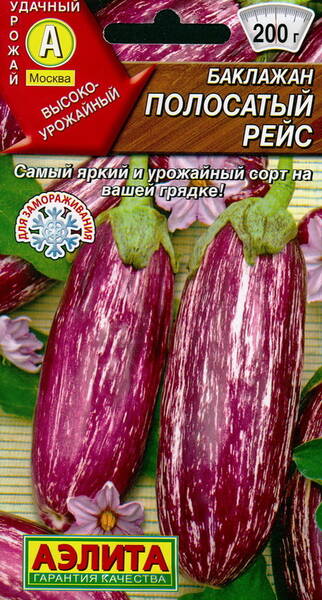A vibrant and bountiful addition to your garden!
Imagine harvesting beautiful, striped eggplants from your own garden! Eggplant "Polosaty reis" (also known as "Striped Flight") is a mid-season variety, perfect for both open ground and temporary greenhouse cultivation. Get ready to enjoy a unique and delicious addition to your culinary creations.
Key Characteristics of "Polosaty reis":
- Eye-Catching Appearance: The fruits are a stunning blend of purple and white stripes, making them a visual delight in your garden and on your plate.
- Excellent Taste: The flesh is known for its mild and slightly sweet flavor, free from any bitterness, ensuring a delicious culinary experience.
- Consistent Yield: This variety boasts reliable fruit set and good productivity, offering a satisfying harvest. Expect a yield of 4.5-5.5 kg per square meter.
- Heat Tolerance: "Polosaty reis" demonstrates good heat resistance, making it a reliable choice for warmer climates and greenhouse growing.
- Medium-Early Maturation: Enjoy your harvest in approximately 120-140 days from seedling emergence.
Variety Description:
The "Polosaty reis" eggplant is a medium-early maturing variety, typically ready for harvest in 120-140 days from germination. The plants are tall and semi-spreading, requiring some support as they grow. The fruits themselves are oval-cylindrical, weighing between 190-200 grams. The striking striped pattern is what truly sets this variety apart. The flesh is a creamy white, offering a dense and firm texture, and most importantly, it's guaranteed to be free of any bitterness.
Growing and Usage Features:
This variety is well-suited for growing both outdoors and in temporary greenhouses. Its heat tolerance makes it a good option for warmer regions. The eggplants are versatile in the kitchen, lending themselves well to various culinary applications including cooking, canning, and freezing. Enjoy them grilled, baked, stir-fried, or preserved for later use.
Growing Tips for Optimal Harvest:
- Companion Planting: For best results in a greenhouse, grow eggplants separately from other crops, or alongside tomatoes. Avoid planting near cucumbers due to differing humidity requirements. If growing with tall tomato varieties, ensure the eggplants receive ample sunlight.
- Planting Depth: Unlike tomatoes, eggplants prefer shallow planting. The planting hole should only be 1-2 cm deeper than the seedling pot.
- Post-Planting Care: Provide shade and regular watering for the first 2-3 days after planting. Eggplants are sensitive to transplanting due to their relatively weak root system. Consider applying a black yeast solution (1 cup per plant) to support root development.
- Support: Due to the delicate nature of the leaves and stems, provide support for medium to tall plants by staking or using a trellis system.
- Soil Care: Regularly loosen the soil around the plants, gently mounding soil around the base. Water in the morning with warm water (28-30°C).
Plant Formation:
Forming the plants is crucial, particularly for medium and tall varieties, as it significantly impacts the overall yield. To encourage a compact bush with well-developed side shoots, pinch off the top of the main stem when it reaches 25-30 cm in height. Typically, leave two side shoots (suckers) on which the entire crop will form, removing the rest. However, if you have fewer seedlings, you can form the plant into three stems by leaving one additional large sucker.
As the shoots begin to branch, select a strong shoot at each branching point and leave it as the main one. Pinch off the weaker shoot after the second leaf above the ovary, leaving only one fruit on that shoot. Continue this process with all subsequent branching. Depending on the variety and fruit size, leave 5 to 12 fruits on each plant.
In very hot and dry weather, you can leave the non-fruiting lower suckers to protect the soil from drying out. Additionally, every 3-5 days, remove all fruitless shoots, leaves, and side shoots, flowers, and ovaries growing below the branching point of the main stem.
To accelerate ripening, pinch off the tops of the shoots 3-4 weeks before the end of the growing season, stopping their growth. Each skeletal branch of tall plants should be tied separately and very carefully, as they are very fragile and easily broken.
Important Tip: Regularly ventilate greenhouses with eggplants by opening all vents and transoms, as humidity above 65-70% is not permissible. Shade the glass on very hot days.
Watering and Fertilizing:
Eggplants are very demanding of soil moisture, so it should be constantly moderately moist. Lack of moisture in the soil can lead to woody stems, flower drop, and shedding of ovaries and leaves. Watering with cold water will stop plant growth and delay flowering and fruiting.
Therefore, water eggplants before flowering once a week with warm water (+25+30°C) by sprinkling 10-11 liters per 1 sq. m, and in hot weather – 2 times a week (and during flowering and fruiting, water at least 2 times a week with 12-14 liters per 1 sq. meter). Moreover, watering should no longer be done by sprinkling, but only at the root, while ensuring maximum ventilation of the greenhouse. Do not allow condensation to appear on the plants during this time.
Those who visit their summer cottage only on weekends should also water eggplants 2 times, dividing the weekly water rate equally between Saturday and Sunday.
To always have warm water on hand, it is best to build a simple installation for heating water with the sun in the garden or use water from a barrel that stands in the greenhouse. After watering, loosen the soil to a depth of 5-6 cm, while simultaneously hilling the plants.
Modern varieties and hybrids of eggplants (especially tall ones) require frequent application of increased doses of fertilizers. Only then will they realize their potential. Therefore, you need to take the feeding of eggplants very, very seriously. Feedings should be timed to coincide with the main phases of plant development.
With normal soil dressing, the first feeding of plants should be carried out 15-20 days after planting the seedlings with a solution of mullein (1:10) or bird droppings with the addition of 1 tbsp of nitrophoska per 10 liters of solution, using 4 liters per 1 sq. m of plantings. If you do not have organic matter, then take 2 tbsp of nitrophoska per bucket of water.
The second feeding is carried out at the very beginning of fruit formation, when the plant needs phosphorus and potassium most of all, adding 1 tbsp of nitrophoska and 0.5 cups of ash to a bucket of the same solution of mullein or bird droppings. The third feeding with the same solution is carried out 15 days after the second feeding.
During flowering and fruiting, it is recommended to sprinkle the soil with wood ash in addition to liquid feeding, 1 cup per 1 sq. m of the bed.
All root dressings are done on moist soil, i.e., the plants must be watered a day before feeding. After feeding and watering, the plants must be hilled.
Harvesting:
Harvesting eggplants begins 30-35 days after flowering in the phase of technical ripeness, when they reach the size and color typical of the variety. These eggplants are usually glossy, with a beautiful purple color (in most varieties). Overripe eggplants are brown, matte, and have coarse and tasteless flesh.
The fruits are harvested every 5-6 days. They are cut with a pruner and placed in a basket. Do not tear off the fruits with your hands, as this causes severe trauma to the plant. Harvesting must be completed before frost, as frozen fruits are tasteless.
Harvested eggplants quickly lose their taste and shrivel. But in a dry and cool room, they can be stored for about a month. They can also be stored in the refrigerator for some time.
Enjoy the unique beauty and flavor of Eggplant "Pol












